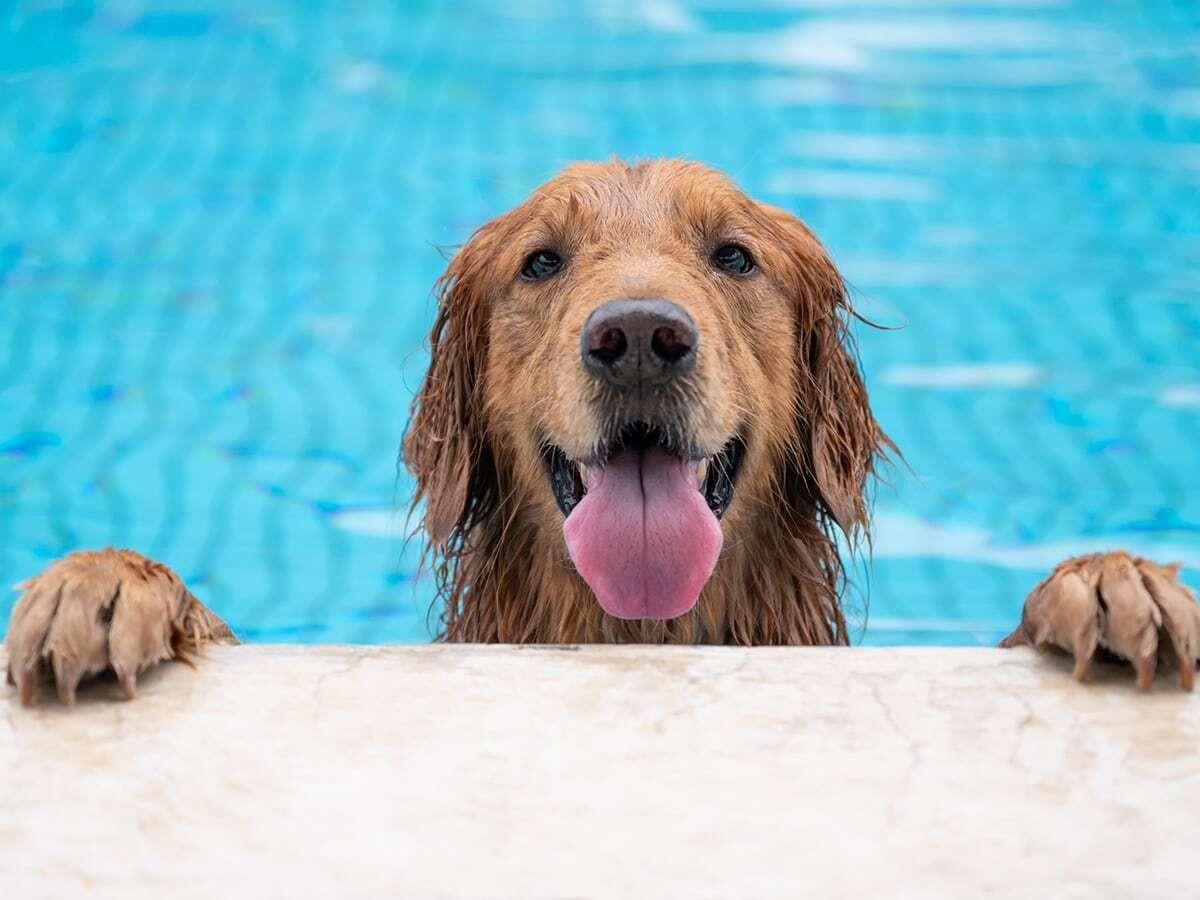Canines may appear to be natural swimmers, but this is not always the case. Almost every breed of dog can swim, some are inherent swimmers and some you have to teach, but it is still an individual preference rather than a generalized rule.
There’s no way to know your pal’s swimming abilities until you introduce them to H2O and teach them the fundamentals:
Choose a peaceful, shallow area of water.
While your dog is learning, keep them on a leash.
Enter the water with them.
Begin near the water’s edge and remain as long as they like.
If they refuse to go, don’t force them, especially if it’s a deep hole.
Lift your dog’s hind legs to demonstrate to them how to float when they start paddling with their front legs.
Which Breeds are the Best Swimmers?
Swimming is easier for some breeds because they were bred and evolved expressly for water jobs. Tollers, for example, were bred for hunting reasons and were required to lure and collect waterfowl from marshes.
The following breeds excel in swimming:
Spanish & Portuguese Water Dog
American & Irish Water Spaniel
Nova Scotia Duck Tolling Retriever
English Settler
Which Dog Breeds Can’t Swim Well?
Dogs who have difficulty swimming have comparable features. Because of their shorter snouts and flat features, brachycephalic breeds such as French Bulldogs and Pugs frequently struggle to be immersed in water. They also have sturdier bodies, which are more difficult to keep afloat with their small legs.
There are many breeds of dogs that cannot swim naturally, and if you own one of these dogs (or a cross-breed with one of these types as parents), you must exercise caution while transporting them to regions with deep water.
The following dog breeds typically have difficulty with swimming:
These are just some of the breeds that have difficulty swimming.
How to Train your Dogs to Swim
It is recommended to begin teaching a dog to swim in a shallow area where you may walk with your pet. Put on your dog’s life jacket, attach the leash, and take a leisurely walk into the water. Allow your dog to become accustomed to having damp paws.
Walk your dog into the shallow water and back out again to teach her that she can get out if she becomes overwhelmed.
If your pet is hesitant, enter the water with a cheerful tone of voice and lots of vocal praise. Keep an eye on your dog’s body language to ensure she’s pleased and confident, especially as you progress into deeper water.
If your dog needs to start paddling to keep afloat, you can use an arm to provide some more support under her belly. This encourages her to paddle her back legs in addition to her front legs.
You don’t want your dog to swim using only her front legs since she would tire soon and splash everywhere. Continue to support her beneath her tummy until she appears to be at ease in the water and is swimming with all four limbs. Keep the first full-body swimming session brief so your dog does not become overtired.
If she appears to be panicked at any moment, back up into the shallow water and wait for her to calm down before attempting again.
What are the Benefits of Swimming for Dogs?
Swimming is a terrific way for people to stay in shape or heal from injury, and your dog is no exception.
It’s suitable for groups.
If your dog has arthritis, dysplasia, or an orthopedic injury, the pool is an excellent area for rehabilitation. Swimming is a low-impact, non-weight-bearing activity that does not impose strain on joints and tendons. Swimming in warm water can help reduce pain, increase blood flow, and aid with injury healing.
It’s ideal for dogs who are overweight.
Overweight or obese dogs frequently have trouble moving about on land. Swimming allows overweight dogs to be active while reducing the danger of strain or injury. Swimming, in conjunction with dietary adjustments, can aid in the weight loss of large dogs.
It boosts general health.
According to experts, one minute of swimming is equivalent to four minutes of running. Swimming increases aerobic capacity and circulation.
How to Keep your Dog Safe in the Water?
DO look for the beach lifeguard: Before going into the water, find out whether there is a lifeguard on duty and where he or she is located on the beach. This will help if your dog gets into trouble.
DO NOT LET YOUR DOG DRINK SEA WATER: Keep swimming sessions brief, with plenty of beach breaks to rehydrate and relax.
DO remain on the beach if you see indicators of trouble: In an emergency, dog owners are not encouraged to enter the ocean or put themselves in danger. Instead, call a duty lifeguard or the coastguard at 999. While you wait for rescue, stand on the beach and call your dog repeatedly.
DON’T LEAVE YOUR DOG SWIMMING UNATTENDED: Accidents can happen in seconds, so stay alert and keep an eye on your pup at all times.
DO check the water temperature ahead of time: As previously said, cold water requires greater energy from swimmer dogs. As a result, allowing your dog to swim in extremely cold or ice conditions is not a good idea.
DO begin swimming sessions in shallow water: Introduce your dog to water at the shallow end of the pool, using treats to motivate your dog with positive-rewards-based training. You should only urge children to swim to deeper depths if you are confident that they are comfortable.
DO think about buying your dog a life vest: When dogs aren’t comfortable in the water, they prefer to paddle madly with their front legs, which causes them to tire faster. A life jacket can add an extra layer of protection, which is especially beneficial for swim training.
Post-Swim Dog Care
The terrible “wet dog” stench is one of the hazards of water play. After your dog has finished swimming, give them a nice rinse, towel dry, and brush completely. Dry your dog’s ears carefully to minimize infection, especially in dogs with floppy ears like Labrador retrievers. Examine your dog for ticks and cuts.
Swimming is strenuous exercise, so provide lots of fresh drinking water and even a treat or two afterward.
Spread out a blanket in the shade and enjoy a well-deserved siesta when your pooch is clean, dry, and exhausted from their swim!
Conclusion
Dogs love swimming and almost all breeds excel at it, but some might need training. When teaching your buddy to swim, the younger they are, the better. Maintain a cheerful and stress-free environment for them during the lesson. Swimming can also be threatening at times if the waters are unknown. Ensure that you check all the prerequisites first and then allow your dog to swim its heart out.
Happy Mood and Health to your Doggo and lots of Love and Licks to you!

Creative manager by day, pet enthusiast all the time! After 19 years with my dog (hopefully he wins the award for oldest pet in the world), I enjoy spending my days brainstorming tail-wagging content, and sniffing out the latest trends in the pet world.












